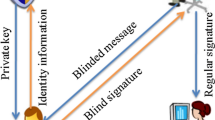Abstract
Partially blind signature scheme is a cryptographic primitive mainly used to design efficient and anonymous electronic cash systems. Due to this attractive application, some researchers have focused their interest on it. Cao, Lin and Xue recently proposed such a protocol based on RSA. In this paper we first show that this protocol does not meet the anonymous property since the bank is able to link a signature with a user. We then present a cryptanalysis of this scheme. In practical applications, a consequence would be the possibility for an attacker to forge, for example, valid $100 bills after the withdrawal of only two bank notes of $1 and $2.
Access this chapter
Tax calculation will be finalised at checkout
Purchases are for personal use only
Preview
Unable to display preview. Download preview PDF.
Similar content being viewed by others
References
Abe, M., Fujisaki, E.: How to Date Blind Signatures. In: Kim, K.-c., Matsumoto, T. (eds.) ASIACRYPT 1996. LNCS, vol. 1163, pp. 244–251. Springer, Heidelberg (1996)
Abe, M., Okamoto, T.: Provably Secure Partially Blind Signatures. In: Bellare, M. (ed.) CRYPTO 2000. LNCS, vol. 1880, pp. 271–286. Springer, Heidelberg (2000)
Cao, T., Lin, D., Xue, R.: A randomized RSA-based partially blind signature scheme for electronic cash. Computers and Security 24(1), 44–49 (2005)
Chaum, D.: Blind Signatures for Untraceable Payments. In: Crypto 1982, Plenum, NY, pp. 199–203 (1983)
Juels, A., Luby, M., Ostrovsky, R.: Security of Blind Digital Signatures. In: Kaliski Jr., B.S. (ed.) CRYPTO 1997. LNCS, vol. 1294, Springer, Heidelberg (1997)
Pointcheval, D., Stern, J.: Security Arguments for Digital Signatures and Blind Signatures. Journal of Cryptology 13(3), 361–396 (2000)
Shamir, A.: On the Generation of Cryptographically Strong Pseudo-Random Sequences. ACM Transaction on Computer Systems 1(1), 38–44 (1983)
Tsiounis, Y.: Efficient Electronic Cash: New Notions and Techniques. PhD thesis, Northeastern University (June 1997)
Author information
Authors and Affiliations
Editor information
Editors and Affiliations
Rights and permissions
Copyright information
© 2006 Springer-Verlag Berlin Heidelberg
About this paper
Cite this paper
Martinet, G., Poupard, G., Sola, P. (2006). Cryptanalysis of a Partially Blind Signature Scheme or How to Make $100 Bills with $1 and $2 Ones . In: Di Crescenzo, G., Rubin, A. (eds) Financial Cryptography and Data Security. FC 2006. Lecture Notes in Computer Science, vol 4107. Springer, Berlin, Heidelberg. https://doi.org/10.1007/11889663_15
Download citation
DOI: https://doi.org/10.1007/11889663_15
Publisher Name: Springer, Berlin, Heidelberg
Print ISBN: 978-3-540-46255-2
Online ISBN: 978-3-540-46256-9
eBook Packages: Computer ScienceComputer Science (R0)




